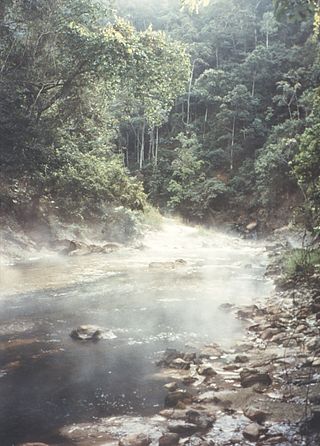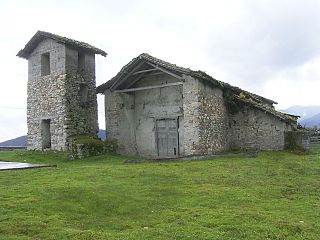
Amazonas is a department and region in northern Peru bordered by Ecuador on the north and west, Cajamarca on the west, La Libertad on the south, and Loreto and San Martín on the east. Its capital is the city of Chachapoyas.

Chachapoyas is a city in northern Peru at an elevation of 2,335 meters (7,661 ft). The city has a population of 32,026 people (2017). Situated in the mountains far from the Peruvian coast, Chachapoyas remains fairly isolated from other regions of Peru. It is served by buses to Chiclayo and Cajamarca, and flights to domestic locations from Chachapoyas Airport.

Tarapoto is a commercial hub town in the San Martín Province of the Department of San Martín of northern Peru. It is an hour by plane from Lima, in the high jungle plateau to the east of what is known as the selva baja. Although Moyobamba is the capital of the region, Tarapoto is the region's largest city and is linked to the Upper Amazon and the historic city of Yurimaguas by a relatively well-maintained transandean highway, paved in 2008–9.

Chachapoyas is a province of the Amazonas Region, Peru. The province of Chachapoyas was a part of the department of Trujillo being its capital the city of Chachapoyas.

The Utcubamba valley is born in the high jalcas of Chachapoyas and runs from the southeast to the northwest to mix with the waters of the Marañón river, forming the immense plain of Bagua. This plain has a warm climate, with temperatures reaching a maximum of 40 °C and the minimum of 21 °C.

La Jalca is a district of the Chachapoyas Province in the Amazonas Region, Peru. Its capital is La Jalca, also known as Jalca, Jalca Grande or La Jalca Grande. It was the first Spanish foundation of the region. The current city of Chachapoyas was established here. Founded in 1538 as San Juan de la Frontera de los Chachapoyas Chachapoyas was later moved to its present location.
Levanto is a district of the province of Chachapoyas.
Shihual cave is located to the north of La Jalca, Peru, and has several caverns. In the interior of these, numerous stalactites and stalagmites have formed that serve as refuge to the different species of night birds of the region.

Chiliquín is one of 21 Peruvian districts that form the Province of Chachapoyas in the Amazon region. Chiliquin is located in the high mountain. Chiliquin offers several attractive places for tourists like ruins and cataracts. There is a church in the center of the village. There is no highway connection to the village.

Huancas is one of the 21 districts of Chachapoyas Province in the Amazonas Region of northern Peru. It is bounded to the north by Valera District, to the east by Sonche District, to the south by Chachapoyas District, and to the west by Luya District and Lámud District.

Magdalena is a district of the province of Chachapoyas in the Amazonas Region of Peru.
Soloco is one of twenty-one districts of Chachapoyas Province, in Peru.
San Juan de Lopecancha is a district of Luya Province in Peru. One of its major points of interest are the ruins of Chachapoya.

Santo Tomás is one of 23 districts of the province of Luya in the Amazonas region of Peru. Santo Tomás is located in the mountains and can have a severe climate. The Saint Tomás region has beautiful cataracts and several ruins of the Chachapoya culture.

The Revash funerary complex is located in Peru's Santo Tomás District, part of Luya Province, which is approximately 60 km to the south of Chachapoyas. The funeral buildings are located at an altitude of 2,800 m above sea level. They are within the calcareous rock formation of Cerro Carbón, located in the margin left side of the vale of Alto Utcubamba. The San José de Laumar River serves as the Southeastern border.

The Señor de Burgos Church is a 17th-century adobe built church located on Plaza de la Independencia in the La Laguna quarter of Chachapoyas, capital of the Amazonas Region of Peru. Señor de Burgos is a venerated local figure to whom is attributed a number of miracles. During its history, it has suffered as the result of several earthquakes, notably in 1929, 1970 and 2005, which have cause changes to the building's structure and appearance.
Cochabamba is an archaeological site of the Inca period in Peru. It is situated in the Amazonas Region, Chachapoyas Province, Chuquibamba District, near the village of Chuquibamba.
Machu Pirqa is an archaeological site of the Chachapoyas culture in Peru. It is located in the Amazonas Region, Chachapoyas Province, Magdalena District. Machu Pirqa is situated at a height of about 1,900 metres (6,234 ft) on the left bank of the river Kuntichaka (Condechaca), an affluent of the Utcubamba River.

Purunllacta or Purum Llacta (possibly from Quechua purum, purun savage, wild / wasteland, llaqta place is an archaeological site in Peru. It is situated in the Amazonas Region, Chachapoyas Province, Soloco District, southwest and near the archaeological site of Purum Llaqta of the Cheto District.













